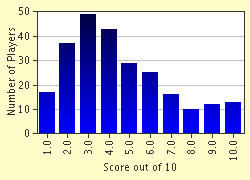Quiz Answer Key and Fun Facts
1. It isn't only coloratura sopranos who have "mad scenes"; the great Marilyn Horne went wonderfully mad playing this title character in an opera by Vivaldi, who was also the subject of an opera by Handel.
2. This famous matricide from classic Greek myth is featured in Gluck's "Iphigenie en Tauride". Pursued by furies following the murder of his mother, he is brought as a captive to the island of Tauris, where his sister (the title character) is a high priestess of Diana. Here he gives way to despair in a memorable "mad scene" in which, at one point, he becomes strangely placid and sings "Le calme rentre dans mon coeur" ("Calm returns again to my heart"). The agitated orchestral accompaniment, however, betrays his true state of mind. Who is he?
3. This rather high-strung lady from classic Greek mythology is among the principal characters in Mozart's early opera "Idomeneo", where she suffers the pangs of unrequited love for the title character's son, Idamante. When the latter throws her over for her rival, the Trojan princess Ilia, she goes spectacularly mad in the furious aria "D'Oreste, d'Ajace", which ends with her running from the stage laughing maniacally. It's enough to give a girl a complex! Who is she?
4. Dame Joan Sutherland was fond of referring to many of her greatest roles as "batty dames". Arguably the "battiest" would be the heroine of this Bellini opera, who has no less than three mad scenes during the course of the evening (actually three and a half, since she regains her sanity halfway through another scene). Maybe she's driven mad by the tenor's high notes, he has to reach two D-flats and one high F. What is the opera?
5. Gaetano Donizetti suffered from mental illness himself and died insane, so it is probably significant that many of his operatic heroines suffer from madness. Which of these Donizetti heroines does NOT go mad?
6. The title character of this early Verdi opera is based on the historical king of Babylon, who had conquered Jerusalem and taken the Jews captive. Shortly after his entrance in Act I, he places a crown upon his head and proclaims himself, not only king, but God as well. This arouses the ire of the Genuine Article, who sends down a bolt of lightning to knock off the monarch's crown, and he spends much of the rest of the opera completely insane and dominated by his daughter. What is the opera?
7. This title heroine of a French opera is somewhat vexed when her fiance abandons her to seek some buried treasure and never returns. However, when her pet goat disappears as well, she becomes completely undone and begins playing a game of tag with her own shadow. Who is she?
8. Mussorgsky's famous "Boris Godunov" concerns a Russian czar who has ascended the throne by murdering his predecessor's heir and is tormented by guilt thereafter. In one memorable scene, Boris imagines that he sees the ghost of the murdered Dmitri in one of the furnishings of his apartment. Where does he see the ghost?
9. The 20th century opera "Cardillac" concerns a demented Parisian jeweller who becomes so enamored of his creations that he murders his customers in order to get them back. "Cardillac" is the creation of which eminent German composer?
10. This 20th century opera by the Polish composer Kristof Penderecki concerns a community of nuns who appear to have become demonically possessed by a prominent clergyman. Only after the offending clergyman has been quite brutally and sadistically tortured and put to death is it revealed that the whole thing was a hoax. Whoops! What is the opera?
Source: Author
jouen58
This quiz was reviewed by FunTrivia editor
Bruyere before going online.
Any errors found in FunTrivia content are routinely corrected through our feedback system.

